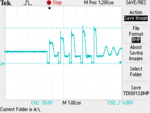bowman1710
Full Member level 3
Hi guys,
I have a flyback design taking 50V to 12V @ 1.25A, switching at 1MHz. The transformer has a LP of 66uH with 36T primary and 9T secondary (3.5 ratio). The switching waveform attached is the primary waveform. The primary ramps to over 100V, on the secondary side the the waveforms have large spikes. Any ideas where i have gone wrong with my transformer?

I have a flyback design taking 50V to 12V @ 1.25A, switching at 1MHz. The transformer has a LP of 66uH with 36T primary and 9T secondary (3.5 ratio). The switching waveform attached is the primary waveform. The primary ramps to over 100V, on the secondary side the the waveforms have large spikes. Any ideas where i have gone wrong with my transformer?

